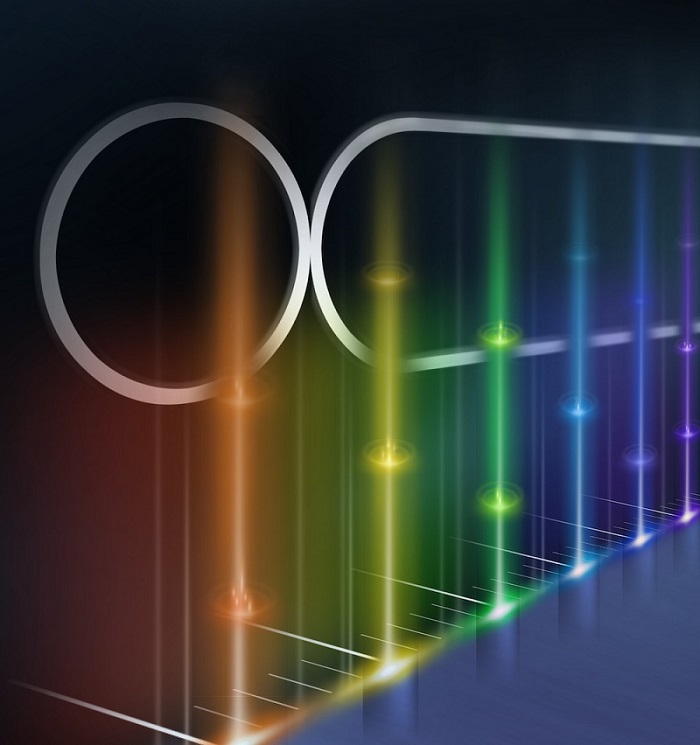
High-Efficiency Frequency Comb Invites Range of Optical Endeavors
On-chip laser frequency combs are a promising technology for applications including environmental monitoring, optical computing, astronomy, and metrology. However, the inability to design an on-chip laser frequency comb that is both efficient and broad has stymied researchers for years and hindered the widespread commercialization of these devices.
Now, a team from the Harvard John A. Paulson School of Engineering and Applied Sciences (SEAS) has developed an electro-optic frequency comb that is 100× more efficient and has more than twice the bandwidth of previous versions. The research integrates the concepts of high efficiency and broad bandwidth to address the efficiency-bandwidth trade-off that currently exists in resonator-based electro-optic frequency combs.

An on-chip frequency comb combines a coupled resonator with an electro-optical frequency comb to improve the efficiency of frequency combs and improve the bandwidth. Potentially supported applications span optical communications and computing to optical metrology. Courtesy of Yiqing Pei/Harvard SEAS.
The high-efficiency, broadband electro-optic frequency comb builds on previous work by the SEAS team; in 2019, the team demonstrated what it reported to be the first stable, on-chip frequency comb that could be controlled with microwaves. This electro-optical frequency comb, built on a lithium niobate platform, spanned the entire telecommunications bandwidth but had limited efficiency. In 2021, the team developed a coupled resonators device to control the flow of light. The researchers used the device to demonstrate on-chip frequency shifters that could change the color of light with nearly 100% efficiency.
The recently developed on-chip frequency comb from the SEAS team integrates a coupled resonator with an electro-optical frequency comb to improve both efficiency and bandwidth. In experiments, it demonstrated a conversion efficiency of 30% and an optical span of 132 nm, based on a coupled-resonator platform on thin-film lithium niobate.
According to researcher Yaowen Hu, the demonstrated comb improved efficiency without sacrificing bandwidth. "In fact, we actually improved bandwidth,” Hu said.
The researchers also showed that the electro-optic frequency comb could serve as an integrated femtosecond pulse source. As an example, in the ultrafast and high-power regime, the team demonstrated a frequency comb with simultaneous electro-optic and third-order nonlinearity effects. The ability to generate on-chip femtosecond pulses is important for nonlinear photonics, optical atomic clocks, optical sensing, and time-bin-encoded optical computing.
“We found that when you improve the performance of the comb source to this level, the device starts operating in an entirely new regime that combines the process of electro-optic frequency comb generation with the more traditional approach of a Kerr frequency comb,” former SEAS postdoctoral fellow Mengjie Yu said.
An on-chip frequency comb that simultaneously achieves a high efficiency and wide span could have significance for a range of optical applications. For example, a hundredfold improvement in comb efficiency could lead to a 20-dB increase in the signal-to-noise ratio of frequency-multiplexed applications such as optical communications. The advanced on-chip frequency comb could also reduce the optical pump power needed to operate optical neural networks. In addition, microwave-power consumption could be reduced by integrating on-chip microwave resonators with the high-efficiency, broadband, on-chip, electro-optic frequency comb source. The high conversion efficiency of the on-chip frequency comb could lead to a new generation of broad electro-optic combs for entangled photons, broadly enabling frequency-domain quantum information processing.
The research was published in Nature Photonics (www.doi.org/10.1038/s41566-022-01059-y).
Published: September 2022